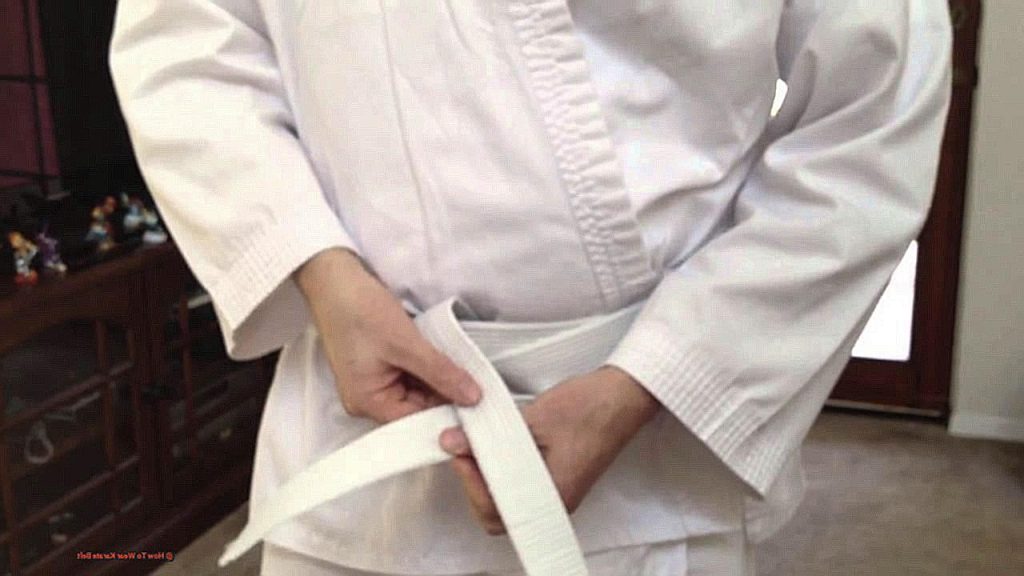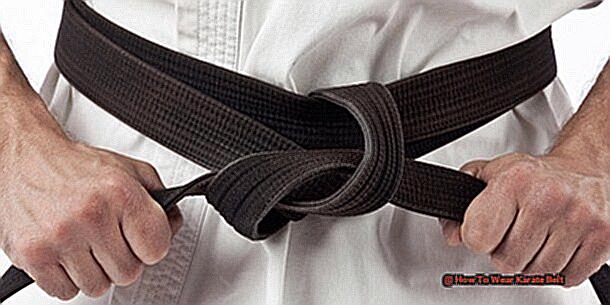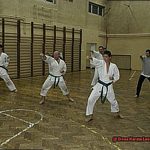Welcome to our blog post dedicated to the art of wearing a karate belt. Whether you are a seasoned practitioner or simply intrigued by this iconic piece of attire, we have all the information you need to know. In this post, we will delve into the history and symbolism behind the karate belt, as well as its various colors and what they represent. We’ll also uncover the process of earning each belt rank and how it reflects one’s personal growth in their martial arts journey. So grab your favorite cup of tea (or coffee) and prepare to discover the powerful meaning behind this humble accessory. Here are some key points we will cover:
- The evolution of the karate belt and its origins in ancient martial arts
- The significance of each colored belt in relation to different stages of training
- How earning higher belt ranks reflects dedication, discipline, and perseverance
- Tips for properly tying your karate belt for optimal performance and comfort
So whether you are a novice white belt or a seasoned black belt, this blog post is for you. Let’s embark on a journey through the world of karate belts together.
How To Wear Karate Belt?
Wearing a karate belt is more than just tying it correctly. It’s about respecting the significance of each color and rank in traditional karate. To properly wear a karate belt, follow these steps and continue to improve your practice:
- Begin by placing the center of the belt on your abdomen, just above the navel.
- Wrap both ends of the belt around your waist, crossing them in the back.
- Bring the ends back to the front, passing them under the crossed portion of the belt.
- Cross the ends over each other and bring them back around to the front.
- Tie your belt by wrapping it around the front of your body.
- Place the center of the belt against your midline, just below your navel.
- Pull the ends behind you and cross them at the small of your back, with the left side overlapping the right, before bringing them back in front of you.
- Adjust the belt so that it sits comfortably on your waist and is snug but not too tight.
- Make sure both ends of the belt hang down evenly, with the tips reaching around 15-20 cm below your waist.
- Remember to untie and retie your belt properly when switching to a new one.
Wearing a karate belt with precision and dedication is an important aspect of this martial art.
Understanding the Different Ranks and Colors in Karate
The belt system in karate is composed of 8 distinct colored belts, each representing a unique level of knowledge and skill. The progression moves from white to black, with white signifying a beginner level and black denoting mastery. Each rank, also known as “kyū,” is typically earned through dedicated training and testing, with the duration between ranks varying depending on the individual’s style and progress.
Here is a breakdown of the different ranks and colors in karate and their corresponding meanings:
| Rank | Color | Meaning |
| White Belt | Beginner | A representation of innocence, lack of knowledge, and a blank canvas waiting to be filled with learning. |
| Yellow Belt | Novice | The first step towards growth and development in karate. |
| Orange Belt | Beginner Practitioner | An indication that the student has begun to grasp the basic techniques of karate. |
| Green Belt | Intermediate Practitioner | A symbol of growth and progress in learning, with a focus on perfecting techniques. |
| Blue Belt | Advanced Practitioner | A demonstration of a deeper understanding of techniques and principles. |
| Purple Belt | Semi-Expert Practitioner | An intermediate level between advanced practitioner and expert. |
| Red Belt | Expert Practitioner | Achieving this rank showcases a high level of skill and knowledge in karate. |
| Brown Belt | Master Practitioner | Just one step away from reaching the highest level of mastery in karate. |
| Black Belt | Master | A representation of ultimate mastery and the highest level of knowledge and skill in karate. |
As practitioners advance through the ranks, they also develop a deeper understanding and appreciation for the discipline, history, and philosophy of karate. Each rank builds upon the previous one, and achieving the black belt not only signifies physical prowess but also mental and spiritual growth.
It is essential to note that the belt system is not a competition, but rather a personal journey towards growth and improvement.
Preparing to Wear Your Karate Belt: Proper Placement and Positioning
The correct placement and positioning of a karate belt before tying it is crucial for both practical and symbolic reasons. It symbolizes a practitioner’s commitment and growth in the art, and also ensures that the belt remains secure during training. Here are the essential steps to properly place and position a karate belt before tying it:
- Select the appropriate size belt: Before starting the tying process, ensure that you have the right belt size. A belt that is too long will be challenging to tie and might come undone during training, while a belt that is too short will not provide sufficient coverage and may also come untied.
- Find a flat, solid surface: It is vital to have a level and durable surface to tie your belt on. This will provide stability and prevent the belt from slipping or coming undone easily.
- Arrange the belt correctly: Lay the belt out with the white or light side facing upwards. This represents starting with a blank slate and being open to learning.
- Tie in a well-lit area: Ensure that you are tying your belt in a well-lit area so that you can clearly see what you are doing. This will guarantee that your belt is properly tied.
- Cross the ends in the center: Gather the two ends of the belt and cross them in the middle of your body, just below your belly button. This is where your karate uniform jacket should overlap.
- Wrap the shorter end around your waist: Take the shorter end of the belt and wrap it around your waist, crossing over the longer end of the belt.
- Create a loose knot: Form a loose knot by crossing the longer end of the belt over the shorter end.
- Pass the longer end through: Take the longer end of the belt and pass it through the loop created by the knot.
- Tighten and adjust: Pull both ends of the belt to tighten it, ensuring that it is snug but not too tight. Adjust the placement of the belt so that it is centered and not twisted.
- Finish with a square knot: To secure the belt, tie a square knot by crossing the ends once again and pulling them through the opposite loops.
By following these essential steps, you can properly place and position your karate belt before tying it, showcasing your dedication and progress in the art.
Step-by-Step Guide on How to Tie a Karate Belt
The art of tying a karate belt is a multi-step process, with each step holding its own unique meaning and purpose. These steps consist of locating the center point of the belt, encircling it around the waist, criss-crossing the two ends at the back, forming two knots or loops, and fine-tuning and fastening them for a secure finish. Depending on the school or style, there may be additional steps or variations involved in this process.
As a seasoned karate practitioner, I have witnessed first-hand the importance of properly tying one’s belt. It not only serves as a symbol of dedication and respect to the martial arts, but it also helps to keep the uniform in place during rigorous training sessions.
The first step in tying a karate belt is to locate the center point of the belt. This can be done by folding it in half and ensuring both ends are equal in length. Next, wrap the belt around your waist, with one end hanging longer than the other. Then, cross the two ends at the back, ensuring they are positioned evenly.
Now comes the trickiest part – creating two knots or loops. To do this, take the longer end and wrap it around both strands of the belt at your waist. Pull it through the resulting loop and tighten it slightly. Then, take both ends and pull them down to create another loop. Again, pull the longer end through this loop and tighten it.
Finally, adjust and tighten both knots or loops until they are secure and evenly positioned at your waist. Congratulations. You have successfully tied your karate belt.
While this may seem like a straightforward process, learning to tie a karate belt correctly takes practice and patience. Just like how mastering martial arts takes time and dedication, so does tying a karate belt.
Tips for Adjusting and Maintaining Your Karate Belt
For optimal fit and performance, it is advised to regularly check and adjust the tightness of your karate belt – at least once a week or before each training session. This will guarantee that the belt stays securely in place during physical activity while also allowing for comfortable breathing. It is crucial to find the appropriate size and properly tie the belt to prevent any discomfort or distractions during practice.
Tips for Adjusting and Maintaining Your Karate Belt:
Regularly check and adjust the tightness of your karate belt to ensure optimal fit and performance.
This should be done at least once a week or before each training session.
This helps keep the belt securely in place during physical activity while also allowing for comfortable breathing.
Make sure to find the right size and properly tie the belt to avoid any discomfort or distractions during practice.
Adjusting your karate belt should be a regular part of your training routine to ensure optimal performance and comfort.
Remember, proper fit and maintenance of your karate belt can greatly impact your overall performance. So make sure to take the time to regularly check and adjust the tightness of your belt.
Anecdote:
I remember when I first started practicing karate, I didn’t pay much attention to adjusting my belt. But one day during a sparring session, my belt kept coming loose and I had to keep adjusting it mid-fight. Not only was it distracting, but it also affected my movement and performance.
Switching Belts: Showing Respect for the Art and Your Instructor
Switching belts in karate is not solely a matter of changing attire; it is a display of respect for the art and one’s instructor, a way to adhere to proper etiquette and show dedication to personal growth. In the dojo, etiquette plays a crucial role in demonstrating respect for the art of karate, fellow karatekas, and instructors. This encompasses appropriate clothing, behavior, and attitude towards training. Regularly adjusting and checking the tightness of one’s belt is one aspect of this, showcasing attention to detail and reverence for the art.
Furthermore, switching belts in karate also exhibits respect for instructors. Instructors are highly esteemed figures in the dojo, as they are responsible for teaching and guiding students on their martial arts journey. By correctly tying and wearing their belt, students express their commitment to learning and improving under their instructor’s tutelage. It also reflects discipline and humility, essential traits in martial arts.
In addition to proper belt etiquette, there are other ways that switching belts can demonstrate respect for both the art and one’s instructor. This includes arriving punctually for class, informing the instructor of any injuries or concerns before training, and following instructions with focus and dedication. By doing so, students exhibit respect for the dojo, equipment, and their fellow karatekas.
Moreover, switching belts signifies a significant milestone in a student’s martial arts journey. As they progress through various ranks and switch belts accordingly, it showcases their unwavering commitment to continuous learning and improvement in the art of karate. This dedication to growth and development is highly valued by both the art itself and instructors.
To conclude, switching belts in karate is not merely a mundane act of changing attire; it symbolizes respect for the art and one’s instructor.
Common Mistakes to Avoid When Wearing a Karate Belt
These blunders not only hinder their performance but also demonstrate a lack of reverence for the art and its customs. In this section, I will discuss some of the most common mistakes people make when donning a karate belt and provide tips on how to avoid them.
- Selecting the wrong size: One of the most prevalent errors is selecting a belt that does not fit properly. Accurate waist measurement is crucial, and the belt should be twice your waist size plus an additional 10 inches. This ensures that the belt is of sufficient length to be tied properly and remain in place during training.
- Tying the belt too tightly: Another mistake is tying the belt too tightly, restricting movement and impacting performance. Remember, the belt should be snug but not uncomfortable. If you find it difficult to breathe or move, then your belt is too tight.
- Not washing the belt regularly: Your karate belt should be washed regularly to maintain cleanliness and prevent bacteria buildup. This is especially important if you train in a sweaty environment or have a skin condition that can be exacerbated by bacteria on the belt.
- Failing to adjust the length as you progress: As you advance through the ranks and earn new belts, it is essential to adjust the length accordingly. This not only ensures a proper fit but also displays respect for your instructor and fellow students.
- Wearing someone else’s belt: Never wear someone else’s karate belt as it is disrespectful and dishonest. Each belt represents an individual’s journey and accomplishments in karate, and it should never be worn by anyone else.
- Avoiding washing the belt: Steer clear of washing your karate belt as it can wash away your hard work and cause it to lose shape and color. Instead, air it out or gently brush it with a soft cloth. This will help keep the belt clean without damaging it.
By avoiding these common mistakes, you can demonstrate reverence for the art of karate and its traditions, and ensure that you are properly attired for training. Remember, your karate belt is more than just a piece of clothing; it is a symbol of your dedication and growth in the art.
Conclusion
In conclusion, wearing a karate belt is not simply about tying it correctly.
It holds a deeper meaning rooted in history and symbolism, representing the dedication and perseverance required in one’s martial arts journey. Each belt rank earned signifies progress and growth, making proper maintenance and tying of the belt an essential aspect of the practice.
Not only does it ensure optimal performance, but it also shows respect for the art and one’s instructor. Avoiding common mistakes such as choosing the wrong size or neglecting to adjust the length as you advance demonstrates reverence for karate traditions and personal development.
Whether you are a beginner white belt or an experienced black belt, wearing a karate belt is a crucial part of this discipline that demands commitment and honor.







